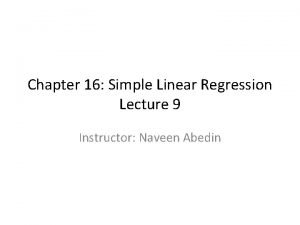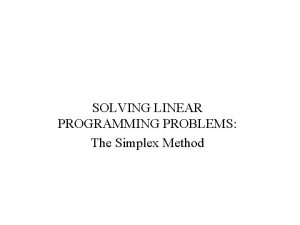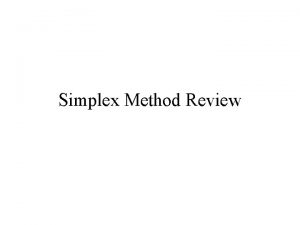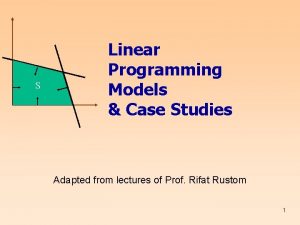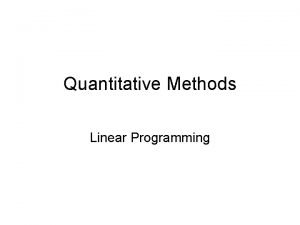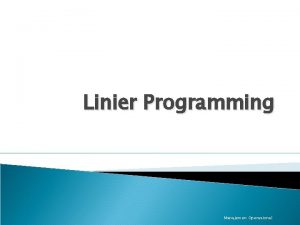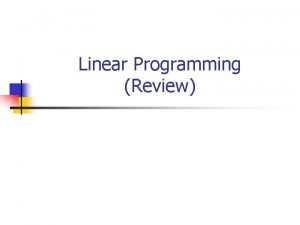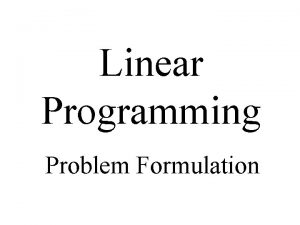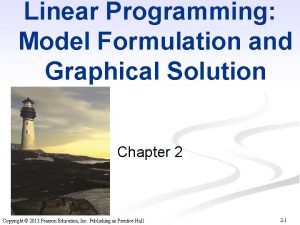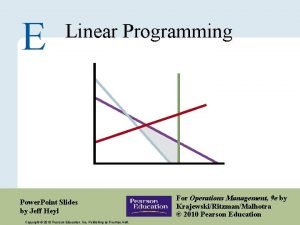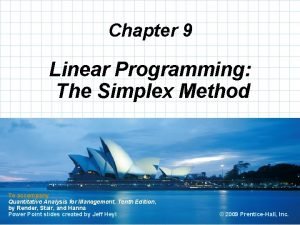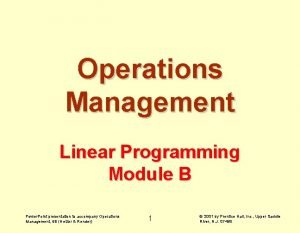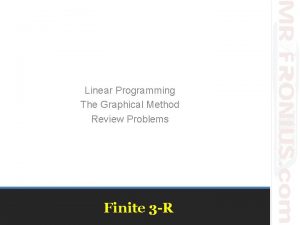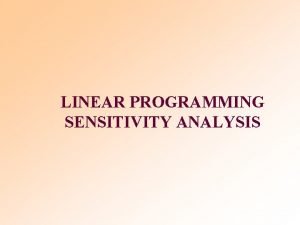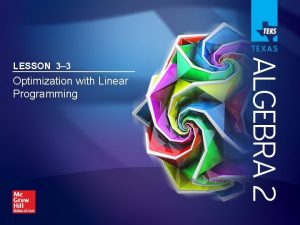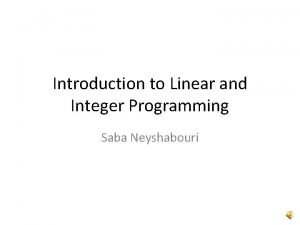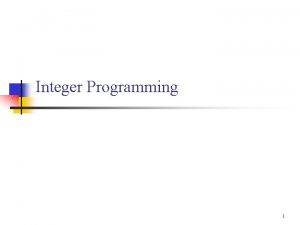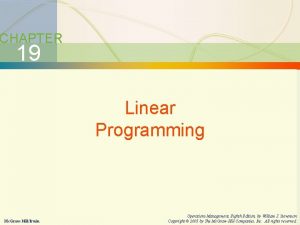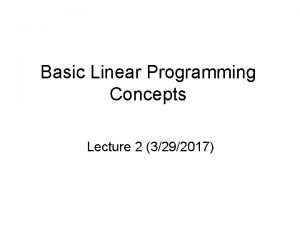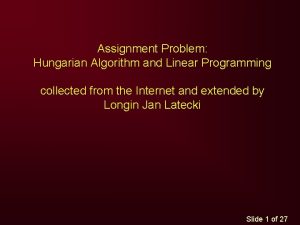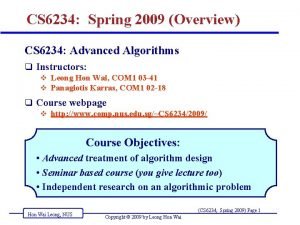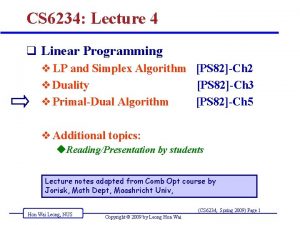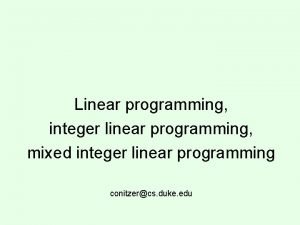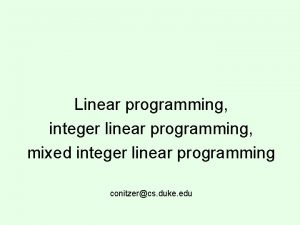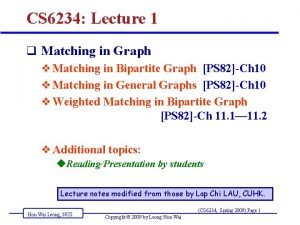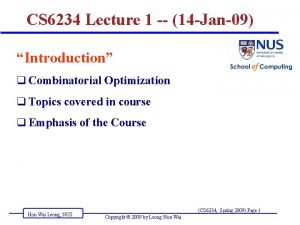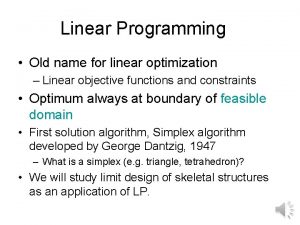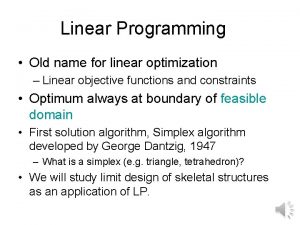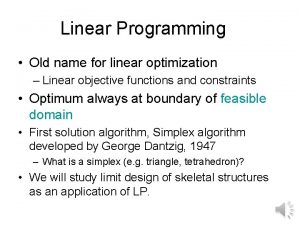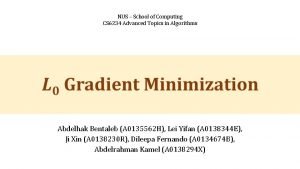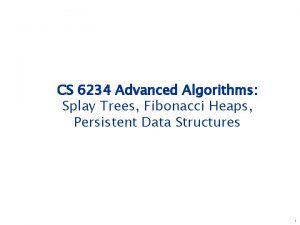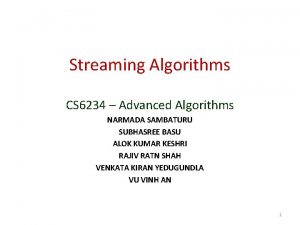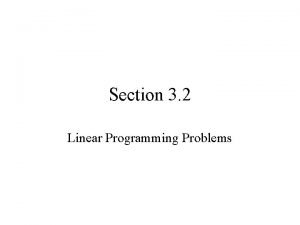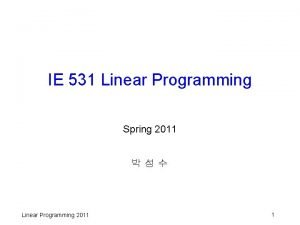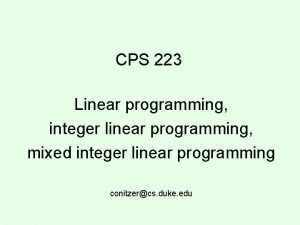CS 6234 Lecture 4 q Linear Programming v
![CS 6234: Lecture 4 q Linear Programming v LP and Simplex Algorithm [PS 82]-Ch CS 6234: Lecture 4 q Linear Programming v LP and Simplex Algorithm [PS 82]-Ch](https://slidetodoc.com/presentation_image/75faa2010f3ba9285c24d05ea542d14c/image-1.jpg)
![Combinatorial Optimization Chapter 3 of [PS 82] Duality Combinatorial Optimization Masters OR Combinatorial Optimization Chapter 3 of [PS 82] Duality Combinatorial Optimization Masters OR](https://slidetodoc.com/presentation_image/75faa2010f3ba9285c24d05ea542d14c/image-2.jpg)


































![Some Suggested Exercises: All from [PS 82] • • • Theorem 3. 3 3 Some Suggested Exercises: All from [PS 82] • • • Theorem 3. 3 3](https://slidetodoc.com/presentation_image/75faa2010f3ba9285c24d05ea542d14c/image-37.jpg)

- Slides: 38
![CS 6234 Lecture 4 q Linear Programming v LP and Simplex Algorithm PS 82Ch CS 6234: Lecture 4 q Linear Programming v LP and Simplex Algorithm [PS 82]-Ch](https://slidetodoc.com/presentation_image/75faa2010f3ba9285c24d05ea542d14c/image-1.jpg)
CS 6234: Lecture 4 q Linear Programming v LP and Simplex Algorithm [PS 82]-Ch 2 v Duality [PS 82]-Ch 3 v Primal-Dual Algorithm [PS 82]-Ch 5 v Additional topics: u. Reading/Presentation by students Lecture notes adapted from Comb Opt course by Jorisk, Math Dept, Maashricht Univ, Hon Wai Leong, NUS (CS 6234, Spring 2009) Page 1 Copyright © 2009 by Leong Hon Wai
![Combinatorial Optimization Chapter 3 of PS 82 Duality Combinatorial Optimization Masters OR Combinatorial Optimization Chapter 3 of [PS 82] Duality Combinatorial Optimization Masters OR](https://slidetodoc.com/presentation_image/75faa2010f3ba9285c24d05ea542d14c/image-2.jpg)
Combinatorial Optimization Chapter 3 of [PS 82] Duality Combinatorial Optimization Masters OR

LP in general form min s. t. c´ x a´i x xj ≥ xj = bi ≤ bi 0 free jεN iεM i ε M´ j ε N´ 1. Introduce surplus variables for inequality constraints 2. Replace free variables by two non-negative variables. Combinatorial Optimization Masters OR

In standard form… min s. t. c~´ x~ A~ x~ = b x~ ≥ 0 where A~ has extra columns for x´s in N´, and for slack variables, x~ has extra variables for x´s in N´ and for slack variables, c~ has extra elements for x´s in N´. Combinatorial Optimization Masters OR

Starting the dual The simplex method gives an optimal solution x 0~ to the LP in standard form, with a basis Q, satisfying c~´ – (c. B~´ B~-1)A~ ≥ 0. Thus, π´ = c. B~´ B~-1 is a feasible solution to the problem π´ A~ ≤ c~´ where π ε Rm. Combinatorial Optimization Masters OR

The dual 1. π´ Aj ≤ cj, for j ε N, 2. π´ Aj ≤ cj, for j ε N´, and π´ Aj ≤ –cj, for j ε N´, and hence π´ Aj = cj, for j ε N´. 3. –πi ≤ 0, for i ε M´, or πi ≥ 0, for i ε M´. Objective: max π´ b. Combinatorial Optimization Masters OR

Definition of the Dual Definition 3. 1: Given an LP in general form, called the primal, the dual is defined as follows Primal Dual Min c´x Max π´b a ´i x = b i iεM πi free a ´i x ≥ b i i ε M´ πi ≥ 0 xj ≥ 0 jεN π´ Aj ≤ cj xj free j ε N’ π´ Aj = cj Combinatorial Optimization Masters OR

Strong duality Theorem 3. 1: If an LP has an optimal solution, so does its dual, and at optimality their costs are equal. Proof. Let x and π be optimal solutions to the primal and the dual resp. , then c´x ≥ π´Ax ≥ π´b. From the dual (*) From the primal Combinatorial Optimization Masters OR

Strong duality proof Thus the primal has cost at least as high as the dual. Then, if the primal has a feasible solution, the cost of the dual cannot be unbounded. It has feasible solution π´, and since it is not unbounded, it must have an optimum. The cost of π´ is π´ b = c. B~´ B~-1 b = c. B~´ x 0~ which is the optimal solution of the primal. Together with (*) this suffices to prove the Theorem. Combinatorial Optimization Masters OR

The dual of the dual Theorem 3. 2. The dual of the dual is the primal. Proof. Left as an exercise. Theorem 3. 3: Given a primal-dual pair, either of the following holds: 1. Both have a finite optimum 2. Both are infeasible 3. One is unbounded the other is infeasible Proof. Skip. Combinatorial Optimization Masters OR

Complementary slackness Theorem 3. 4: A pair, x, π, respectively feasible in a primal-dual pair is optimal if and only if: ui = πi (a´i x - bi) = 0 vj = (cj - π´ Aj) xj = 0 for all i for all j. Combinatorial Optimization Masters OR (1) (2)

Complementary slackness (2) Proof: Recall ui = πi (a´i x - bi) & vj = (cj - π´Aj) xj Define u = ui (≥ 0) & v = vj (≥ 0) Thus, u = 0 if and only if (1) holds (each ui = 0) and v = 0 if and only if (2) holds (each vj = 0). Now, notice that (u + v) = c´x – π´b. Thus, if (1) and (2) hold, (u + v) = 0, and c´x = π´b. This implies that x and π have the same objective value, and hence are both optimal. Combinatorial Optimization Masters OR

Complementary slackness (3) Consequences: If an inequality constraint in the dual is not binding, then the corresponding primal variable must have value zero and vice versa. Likewise, if a nonnegative variable has strictly positive value, then the corresponding constraint must be binding. Combinatorial Optimization Masters OR

Tableau (for example 2. 6) Min Z = x 1 s. t. 3 x 1 + 2 x 2 + 5 x 1 + 2 x 2 + 2 x 1 + 5 x 2 + –z 0 1 3 4 + x 2 + x 3 + x 4 + x 5 x 3 x 3 + x 4 + x 5 =1 =3 =4 x 1 x 2 x 3 x 4 x 5 1 3 5 2 1 5 1 1 1 0 1 0 0 1 Combinatorial Optimization Masters OR

Simplex Algorithm (Tableau Form) –z x 1 x 2 x 3 x 4 x 5 0 1 1 1 3 2 1 0 0 3 5 1 1 1 0 4 2 5 1 0 1 x 2 x 3 x 4 x 5 –z -6 -3 -3 0 0 0 x 3 = 1 3 2 1 0 0 x 4 = 2 2 -1 0 x 5 = 3 -1 3 0 0 1 Diagonalize to get bfs { x 3, x 4, x 5 } x 1 x 2 x 3 x 4 x 5 –z 0 1 1 1 x 3 = 1 3 2 1 0 0 x 4 = 2 2 -1 0 x 5 = 3 -1 3 0 0 1 Determine reduced cost by making c~j = 0 for all basic col Combinatorial Optimization Masters OR

Combinatorial Optimization Masters OR

Farkas Lemma Skip 3. 3 Combinatorial Optimization Masters OR

The shortest path problem and its dual Definition 3. 3 Given a directed graph G=(V, E) and a nonnegative weight cj ≥ 0 associated with each arc ej ε E, an instance of the shortest path problem (SP) is the problem of finding a directed path from a distinguished source node s to a distinguished terminal node t, with the minimum total weight. Combinatorial Optimization Masters OR

Shortest path problem Feasible set F is given by F = {P = (ej 1, . . , ejk) : P is a directed path from s to t in G}. Cost c(P) = Σi=1 k cji. Formulation as LP uses node-arc incidence matrix A: aij = { 1 -1 0 if arc j leaves node i -f arc j enters node i otherwise Combinatorial Optimization Masters OR

SP Example e 1 e 2 e 3 e 4 e 5 1 e 1 a 3 2 s t e 3 2 e 5 1 e 2 e 4 A = s 1 1 0 0 0 t 0 0 0 -1 -1 a -1 0 1 1 0 b 0 -1 -1 0 1 b Combinatorial Optimization Masters OR

LP formulation Min e 1+ 2 e 2+ 2 e 3 + 3 e 4 + e 5 s. t. e 1 + e 2 - e 1 e 3 + - e 2 0 ≤ ei ≤ 1, i =1… 5 Combinatorial Optimization Masters OR - e 4 e 5 = 1 = -1 = 0

Redundancy Claim: Any solution that satisfies 3 of the four constraints, satisfies all 4 of them. Easily checked. Thus, we omit the constraint for the sink t. Next, we consider the tableau of a feasible solution Combinatorial Optimization Masters OR

Starting Tableau 1 e 1 a 3 2 s t e 3 2 e 4 e 5 1 e 2 b e 1 e 2 e 3 e 4 e 5 -z 0 1 2 2 3 1 s 1 1 1 0 0 0 a 0 -1 0 1 1 0 b 0 0 -1 -1 0 1 Combinatorial Optimization Masters OR

Summary of LP for SP • Simplex algorithm in tableau form – Cost vector c is also included as a constraint (Read details in [PS 82]-Ch-2) • Each basis has (n-1) edges; Clever idea! – Not all are positive; – Edges with +ve flows are on the (s-t) path • Pivoting – bring in a new edge; – Based on relative cost (row 0 of tableau) Combinatorial Optimization Masters OR

Starting Tableau 1 e 1 a 3 2 s t e 3 2 e 4 e 5 1 e 2 b e 1 e 2 e 3 e 4 e 5 -z 0 1 2 2 3 1 s 1 1 1 0 0 0 a 0 -1 0 1 1 0 b 0 0 -1 -1 0 1 To prepare basis { e 1, e 4, e 5 }: row 2 + row 1; Combinatorial Optimization Masters OR

Initial feasible bfs (1) After we have row-2 row-1 + row-2; 1 e 1 a 3 2 s t e 3 2 e 4 e 5 1 e 2 b -z s a b 0 1 1 0 e 1 e 2 e 3 e 4 e 5 1 1 0 0 2 1 1 -1 2 0 1 -1 3 0 1 0 0 1 Basis { e 1, e 4, e 5 }: e 1=1, e 4=1, e 5 =0, this bfs is degenerate Now, to adjust reduced costs; First, row-0 - row-1 Combinatorial Optimization Masters OR

Initial feasible bfs (2) After we have row 2 row 1 + row 2; After, row 0 - row 1; 1 e 1 a 3 2 s t e 3 2 e 4 e 5 1 e 2 b -z s a b -1 1 1 0 e 1 e 2 e 3 e 4 e 5 0 1 0 0 1 1 1 -1 2 0 1 -1 3 0 1 0 0 1 Then, row-0 – 3*(row-2); Combinatorial Optimization Masters OR

Initial feasible bfs (3) After we have row 2 row 1 + row 2; Then, row 0 + row 1; Then, row 0 – 3*(row 2); -z s a b -4 1 1 0 1 e 1 a 3 2 s t e 3 2 e 4 e 5 1 e 2 b e 1 e 2 e 3 e 4 e 5 0 1 0 0 -2 1 1 -1 -1 0 0 1 Then, row-0 – row-3; Combinatorial Optimization Masters OR

Initial feasible bfs (4) After we have row 2 row 1 + row 2; Then, row 0 + row 1; Then, row 0 – 3*(row 2); Then, row 0 + *(row 3) -z s a b -4 1 1 0 1 e 1 a 3 2 s t e 3 2 e 4 e 5 1 e 2 b e 1 e 2 e 3 e 4 e 5 0 1 0 0 -1 1 1 -1 0 0 1 Basis { e 1, e 4, e 5 }: e 1=1, e 4=1, e 5 =0, this bfs is degenerate Combinatorial Optimization Masters OR

Pivoting (1) 1 -4 1 1 0 3 e 4 2 s Choose col with -ve relative-cost; (bring col e 2 into the basis) Choose pivot from that column; -z s a b e 1 a t e 3 2 e 5 1 e 2 b e 1 e 2 e 3 e 4 e 5 0 1 0 0 -1 1 1 -1 0 0 1 Now, perform: (a) row 1 – row 2; (b) row 3 + row 1; Combinatorial Optimization Masters OR

Pivoting (2) 1 e 1 a 3 2 s Now, to bring e 2 into the basis; After (a) and (b); t e 3 2 e 4 e 5 1 e 2 b -z s a b -4 0 1 1 e 2 e 3 e 4 e 5 0 1 0 0 -1 1 1 0 0 0 1 Now, get reduced cost: (c) row 0 + row 2; Combinatorial Optimization Masters OR

Pivoting (3) 1 -3 0 1 1 3 2 s Now, to bring e 2 into the basis; After (a) and (b); And (c); -z s a b e 1 a t e 3 2 e 4 e 5 1 e 2 b e 1 e 2 e 3 e 4 e 5 0 1 0 1 -1 1 1 0 0 0 1 This solution is optimal. All relative cost (row 0) are positive! Combinatorial Optimization Masters OR

The dual of SP Max πs – πt 1 s. t. π ´A ≤ c ´. π free. e 1 a 3 2 s t e 3 2 b In case of SP: the constraints of the dual are: πi – πj ≤ cij. Combinatorial Optimization Masters OR e 5 1 e 2 e 4

Complementary slackness for SP A path f as defined by primal variables, and an assignment of dual variables π are jointly optimal if and only if: 1. A primal variable with positive value corresponds to a dual constraint that is satisfied at equality. 2. A dual constraint not satisfied at equality corresponds to a primal variable with value zero. Combinatorial Optimization Masters OR

Min e 1 + 2 e 2 + 2 e 3 + 3 e 4 + e 5 s. t. e 1 + e 2 - e 4 - e 5 - e 1 + e 3 + e 4 - e 2 - e 3 + e 5 0 ≤ ei ≤ 1, for i =1… 5 1 e 1 a 2 3 0 e 5 1 e 2 3 2 s 2 b 1 Min πs – πt s. t. πs - πa 1 πs - πb 2 πa - πt 3 πb - πt 1 each πi 0 Compare dual variables π with label used in Dijkstra algorithm for shortest path! Combinatorial Optimization Masters OR e 5 1 e 2 e 4 t e 3 b e 4 t e 3 2 = 1 = -1 = 0 ? 3 s 1 e 1 a

Read up the following sections on your own. Sect 3. 5: Dual Info in the Tableau Sect 3. 6: Dual Simplex Algorithm Sect 3. 7: Intrepretation of Dual Simplex Algorithm Combinatorial Optimization Masters OR
![Some Suggested Exercises All from PS 82 Theorem 3 3 3 Some Suggested Exercises: All from [PS 82] • • • Theorem 3. 3 3](https://slidetodoc.com/presentation_image/75faa2010f3ba9285c24d05ea542d14c/image-37.jpg)
Some Suggested Exercises: All from [PS 82] • • • Theorem 3. 3 3 11 12 13 17 Combinatorial Optimization Masters OR

Thank you. Q&A Hon Wai Leong, NUS (CS 6234, Spring 2009) Page 38 Copyright © 2009 by Leong Hon Wai
 Perbedaan linear programming dan integer programming
Perbedaan linear programming dan integer programming Linear vs integer programming
Linear vs integer programming Definisi linear
Definisi linear 01:640:244 lecture notes - lecture 15: plat, idah, farad
01:640:244 lecture notes - lecture 15: plat, idah, farad C data types with examples
C data types with examples Linear regression lecture
Linear regression lecture Greedy programming vs dynamic programming
Greedy programming vs dynamic programming Runtime programming
Runtime programming Linear programming problems and solutions doc
Linear programming problems and solutions doc Shortest path linear programming
Shortest path linear programming Canonical form lp
Canonical form lp Linear programming case study examples
Linear programming case study examples Non negativity constraints
Non negativity constraints Scope of linear programming
Scope of linear programming Network model linear programming
Network model linear programming Linear programming management science
Linear programming management science Pengertian linear programming
Pengertian linear programming Linear programming word problems
Linear programming word problems Linear programming characteristics
Linear programming characteristics Linear programming problem formulation
Linear programming problem formulation Apa yang dimaksud dengan linear programming
Apa yang dimaksud dengan linear programming Lp model formulation
Lp model formulation Linear vs integer programming
Linear vs integer programming Scope of linear programming
Scope of linear programming Preemptive goal programming examples
Preemptive goal programming examples Linear programming powerpoint
Linear programming powerpoint The zj row in a simplex table for maximization represents
The zj row in a simplex table for maximization represents Operations management linear programming
Operations management linear programming What is zj in simplex method
What is zj in simplex method Graphical method linear programming calculator
Graphical method linear programming calculator Sensitivity analysis
Sensitivity analysis Operation research linear programming
Operation research linear programming 3-3 optimization with linear programming
3-3 optimization with linear programming Saba neyshabouri
Saba neyshabouri Lp relaxation 이란
Lp relaxation 이란 Linear programming models: graphical and computer methods
Linear programming models: graphical and computer methods Operations management linear programming
Operations management linear programming Linear programming basic concepts
Linear programming basic concepts Hungarian method
Hungarian method





